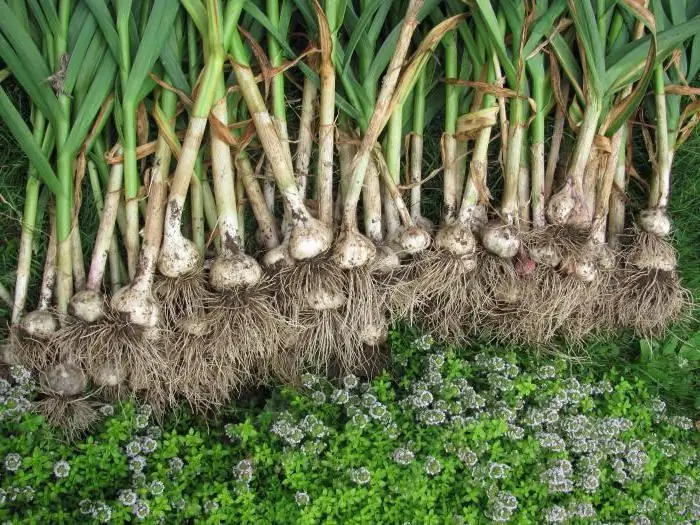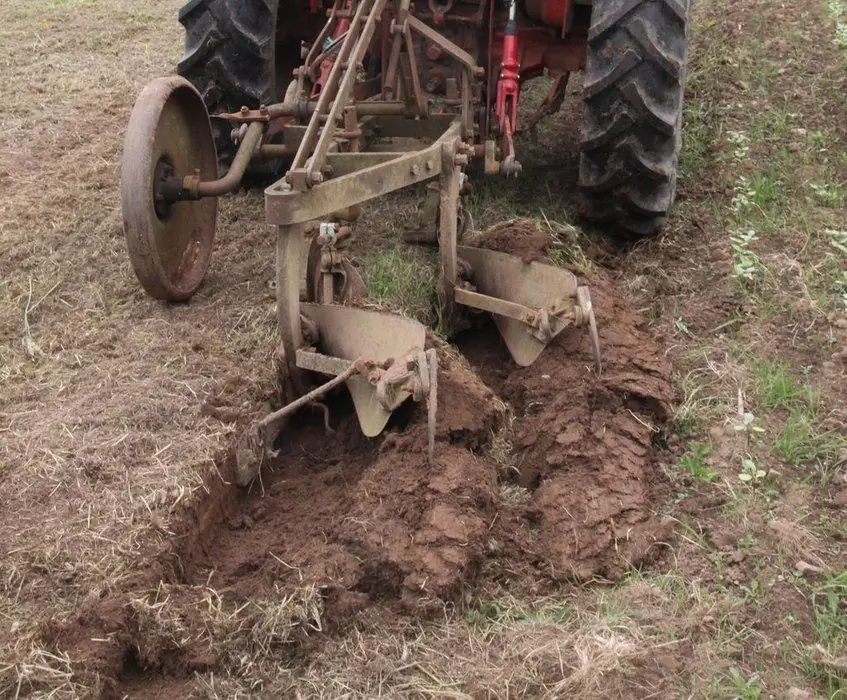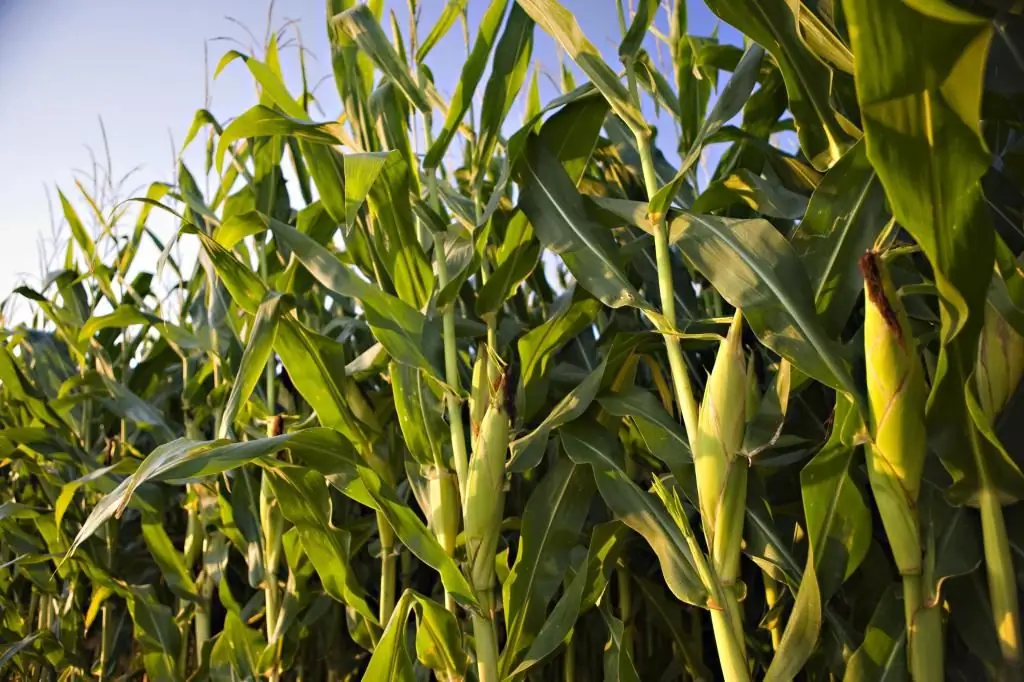2026 Author: Howard Calhoun | [email protected]. Last modified: 2025-01-24 13:10:47
Annual herbaceous plant rapeseed belongs to the cruciferous family, genus Cabbage. A feature of this culture is that it does not have a single wild ancestor. Genetic scientists managed to find out that rapeseed is a natural hybrid of rapeseed and garden cabbage. In the fields, this crop is usually grown for oilseeds or as green manure. The technology of rapeseed cultivation, like any other crop, of course, has some of its own characteristics.
Description of culture
Rapeseed is an annual plant with an upright bluish-green stem, divided into branches of several orders. The leaves of this plant are single-row petiolate, and the inflorescences are racemose, loose, with yellow petals.

The fruit of rapeseed is a slightly bent narrow pod containing about 30 pcs. spherical dark small seeds separated by membranous partitions. Canola pods can be up to 12 cm long.
The seeds of this crop are very small. In 5 g they can contain up to 1000 pieces. This plant reproduces exclusivelyseed method.
The root of rapeseed is rod-shaped. In adult plants, it branches strongly and gradually grows in a horizontal direction.
Biological features
Rapeseed plant is tall. The length of its stem by the end of summer can be 1-2 m. The root system is also very well developed in this crop. In the soil in a vertical direction, it can germinate to a depth of 40 cm.
Outwardly, rapeseed is very similar to other wild and cultivated plants of the Cabbage genus. However, it has one characteristic feature. On the stem of this plant, leaves of three varieties grow at once.
The technology of rapeseed cultivation in any case is not much different from the method of growing most other crops of the cruciferous family.
Inflorescences on rapeseed bloom about 40 days after emergence. The ovaries of pods on this plant are formed by the end of summer.
Origin of rapeseed
This culture has no wild ancestor. However, the technology of rapeseed cultivation in the fields has been known to people for a very long time. As scientists managed to find out, people began to grow this culture as early as the 6th millennium BC. e.

Unfortunately, there is no consensus among scientists regarding the area of distribution of this plant in antiquity. Some botanists believe that the first rapeseed was once cultivated by the inhabitants of the Mediterranean countries. Other scientists believe that this culture began to spread around the world in ancient times from England. According to researchers, around the XVI century. rapeseed fromGreat Britain came first to Germany, and then to Poland and Ukraine.
In Russia, this plant began to be cultivated rather late. For the first time this culture was brought to our country in the 19th century.
Economic value
Rapeseed is widely used by man. In the national economy, this culture is used, for example, for the manufacture of:
- biofuels and industrial oils;
- basics of feed used in animal husbandry;
- cosmetics and detergents;
- edible vegetable oil.
Also, rapeseed is highly valued as a honey crop. The green mass of this plant is comparable to manure in terms of the composition of substances useful for agricultural crops. Therefore, this culture is often used as green manure.
Main varieties
Winter or spring rapeseed is cultivated on the farmer's fields. The first variety of this crop usually produces more abundant crops. It is believed that it is more profitable to cultivate winter rapeseed than spring rapeseed. But at the same time, this variety is also more demanding on growing conditions. For example, spring rapeseed is more drought tolerant.
Winter rapeseed is risky to grow, including because, despite winter hardiness, it can freeze during the cold season. This usually happens when, after early thaws, ice crusts form near the root collars of plants.

Growing conditions
Relates to rape to cold-resistant crops of a long day. Cultivated itplant mainly in temperate countries. In arid regions, rapeseed, unfortunately, does not show high yields. A favorable condition for its vegetation is high humidity.
To the soil, rape is absolutely undemanding. However, it grows best in neutral to slightly acidic soils with a high to moderate nutrient content. That is, they are very good for this culture:
- chernozems;
- dark gray and gray forest soils;
- soddy carbonate, podzolic and viscous earth.
Canola is not grown on soils:
-
heavy in texture;
- with a subsoil layer that does not pass water well;
- peaty;
- lungs with insufficient thermal conductivity;
- s alt licks;
- sour without liming.
Cultivate this crop in Europe, Ukraine, Belarus. In Russia, this plant is grown in the Central regions, in the south and even in Siberia. The technology for cultivating spring and winter rape is the same in almost all regions of our country.
Choice of predecessors for rapeseed
It is believed that this plant is best planted in those fields where row crops used to grow, under which a lot of organic fertilizers were applied. Very good predecessors for rapeseed are:
- lupine and clover;
- cereals and legumes;
- silos.
It is not recommended to plant this plant after beets or any plants of the Cabbage genus. The field must be carefully leveled before planting this crop.
Features of cultivation
In short, rapeseed cultivation technology includes the following operations:
- preparing the soil for planting;
- seed dressing;
- planting seeds;
- field treatment with herbicides;
- watering as needed;
- treatment of fields from pests.
If this crop is cultivated for seeds, it is harvested after the pods ripen. Canola grown as green manure is cut at a young age. Next, the green mass is embedded in the ground.

Technology of cultivation of spring rapeseed for seeds
In this case, nitrogen fertilizers are applied to the soil in the fall for plowing, as well as in the spring directly during sowing. With phosphorus top dressing, the land on the field is usually improved before winter. Spring rape is usually sown in the immediate vicinity of livestock complexes to obtain oilseeds. A feature of this plant is that it responds very well to organic fertilizers. Usually 80-100 tons of manure per hectare are brought under such rapeseed.
The spring form is sown for oilseeds most often in the second decade of May. For example, according to the cultivation technology, rapeseed in Belarus must be planted no later than May 20. Seeds of this culturepre-treated with fungicides and insecticides. Rapeseed planting material is placed in the soil to a depth of 2-3 cm. A gap of 40 cm is left between the rows. The seeding rate is 5-7 kg of seeds per 1 ha. Fields of spring rapeseed grown for seed are usually treated with herbicides only before germination or immediately after.
Harvesting in the fields with this crop can be done in a direct and separate way. The latter technique is used in weedy fields with uneven maturation of plants. In windrows, rapeseed is mowed in the phase of yellow-green ripeness at a seed moisture content of 30-35%. Under no circumstances should this crop be kept on the field. Otherwise, you can lose up to half of the crop. Mow rapeseed with the help of mounted headers. Direct combining of the spring form is done in clean (weed-wise) fields under good weather conditions.
Of course, the technology of cultivation of spring rapeseed has a theoretical justification. Fedotov V. A., Sviridov A. K. and Fedotov S. V., for example, in their book "Agrotechnologies of grain and industrial crops" exactly described the methods of cultivation of this form of culture.
Cultivation of winter rapeseed for seeds
Phosphorus fertilizers in this case are applied under the main tillage. Nitrogen is used in the spring at the very beginning of the growing season. Seeds of winter rapeseed, as well as spring rapeseed, must be processed.
In autumn, the weeds on the field grow very quickly. In some cases, they can even oppress young crop crops. Therefore, pre-emergence herbicidescultivation of the winter form must be used without fail.
Rapeseed of this variety is usually sown in the 1-2 decade of August. In Belarus, the technology for cultivating winter rapeseed, for example, involves planting it on August 10-15. In any case, this procedure is usually carried out a month before the planting of winter crops. A good harvest of rapeseed can only be ensured if it leaves under the snow with the following biometric indicators:
- number of developed leaves - 6-8 pieces;
- thickness of the root neck - 6-12 mm;
- stem height - 3 cm;
- root mass - at least 3 g;
- mass of the plant itself - 20-35 g.

According to the technology, when cultivating rapeseed for oilseeds, it is important to ensure that the plantings of this crop are sufficiently dense. The field with this plant should be inspected in the spring immediately after the snow melts. If a significant sparseness is detected, it is supposed to finish the planting with a spring variety of rapeseed.
Dignity as a green manure
When growing for seeds, the technology of rapeseed cultivation must be followed exactly. The same applies to the method of planting this crop as green manure. Thus, on farms, rapeseed is actually used very often. The advantages of this culture as green manure are:
- the ability to build up a dense green mass in a short time;
- development of the root system, which ensureshigh-quality soil aeration;
- presence in the tissues of essential oils that can reduce the incidence of soil.
The green mass of this plant contains a lot of nitrogen. In this regard, rapeseed is second only to legumes.
Technology of cultivation of winter rapeseed as green manure
Thus, rapeseed is usually sown for various seedling crops: peppers, tomatoes, cucumbers, zucchini, etc. The exception in this case is cabbage. Winter rapeseed is planted when used as green manure after harvesting the main crops. Usually this is the 2-3rd decade of August.
According to the technology of cultivation of winter rapeseed in Belarus, Russia, Ukraine, the soil for the crop is loosened beforehand with a Fokin flat cutter or a cultivator. Mineral and organic fertilizers are also applied to the ground. In this case, they are planted at the rate of 150-200 grams of seeds per hundred square meters. Seeds are pretreated and mixed with sand. The planting material is deepened by 2-3 cm. The row spacing is left at about 15 cm.
According to the established technologies, when rapeseed is cultivated as green manure, it is supposed to be cut with a cultivator about a month before planting the main crops. At the same time, they dig up the earth with turning over the layers.
Cultivation of spring form as green manure
In this case, rapeseed is used as a precursor for winter crops. Sowing of the spring form when used as green manure is carried out from March to August. Such rapeseed grows in the fields before mowing usuallynot for long. Cut it off during the flowering period. The technology of cultivating spring rapeseed as green manure, of course, also involves turning the soil layers after cutting. In order for the green mass in the ground to rot faster, the field after that is also supposed to be additionally watered.

Pests and control measures
According to the technology of rapeseed cultivation in Siberia, the Urals, the Central regions, etc., this crop is supposed to be treated from time to time from insects. Plantings of this annual plant are damaged by various kinds of pests, unfortunately, quite often. Spring rapeseed can be particularly affected by insects. Quite often this culture is damaged, for example, by such pests as:
- Cruciferous rapeseed flea. This pest can infect all green parts of rapeseed. To combat this insect in plantings, insecticides are usually used, made, for example, based on substances such as deltamethrin, dimethoate, fenvalerate.
- Rape beetle. This insect eats unopened plant buds. They fight the flower beetle by spraying the plantings with insecticides during the budding period.
- Onion moth caterpillars. These pests damage the leaves of plants, and sometimes their stems. To combat this pest, agents based on deltamethrin or lambda-cyhalothrin are usually used.
- Cabbage moth caterpillars. This insect usually damages rapeseed leaves. In this case, pest controlinsecticides based on cypermethrin or gamma-cygolatrin are recommended.
The best varieties of winter rapeseed
Selection work with this crop is, of course, quite serious. A variety of varieties of winter rapeseed can be grown in the fields. Most of them are high yielding. But the most popular varieties of this crop among farmers are:
- "Atlant". This variety is great for growing in almost any region of Russia. Its advantages include high yields and abundant branching.
- "Frost". Rapeseed of this variety is usually grown in regions with a cold climate, for example, in Siberia and the Urals. In addition to frost resistance, its advantages include a high degree of resistance to diseases and frost.
The most popular varieties of spring rapeseed
From this group, varieties such as:
- "Salsa KL". This early maturing hybrid is valued by agricultural workers primarily for its good resistance to lodging and seed shedding.
- "VNIS 100". This relatively new variety is mainly suitable for growing in the forest-steppe zone. Its advantages include a high percentage of oil content in the seeds.
Is it possible to grow in the country
To obtain oilseeds, rapeseed is cultivated, of course, only on large farms. As a green manure, this crop is grown, including in private suburban areas. Cultivation technologyand rapeseed harvesting in this case is applied almost the same as in the fields.
For sowing one hundred square meters in suburban areas, about 200 g of seeds are used. If there are animals or birds on the farm, you can plant rapeseed even thicker. You can sow this crop in the garden from early spring to late autumn - as needed.
For convenience, rapeseed seeds are usually mixed with sand at a ratio of 1:50 when planting in a summer cottage. Next, the planting material is scattered over the dug up and leveled area in advance, embedded in the ground with a rake.
The seeds of this crop usually germinate 4-5 days after sowing. Subsequently, growing, rapeseed occupies almost the entire area of the site. This green manure is mowed in the garden, as well as in the fields, in the flowering phase. The green mass is buried in the ground with a shovel.

Instead of a conclusion
Thus, we found out what a plant like rapeseed is. Cultivation technology, biological characteristics, the importance of this crop for agriculture - all this was considered by us in detail. This culture, as you can see, is undemanding and hardy.
Unfortunately, rapeseed is not grown in Russia too much. Recently, however, agricultural enterprises have begun to pay more and more attention to this culture. After all, the benefits of growing this plant (both for oilseeds and as green manure) can actually be obtained simply huge. It is quite possible that in the near future rapeseed will still take its rightful place in the list of cultivated in Russia.agricultural crops.
Recommended:
Garlic cultivation as a business: a business plan, methods and features of technology. Growing garlic on an industrial scale

The owners of suburban areas, by definition, have a few more opportunities to organize a home business. You can, for example, not only engage in gardening or growing fruits and vegetables, but also have pets. Although, of course, many summer residents and aspiring entrepreneurs prefer crop production to caring for animals. This is not only a less labor-intensive undertaking - growing vegetables and fruits does not require such large financial investments and pays off faster
Polis is.. The origin and modern meaning of the word

What is a policy? What does this word mean? Modern insurance policies: required details and features
Spring wheat: cultivation technology, features of sowing, cultivation and care

About 35% of all grain plantings on the planet today falls on wheat. In purchases, the share of such grain is 53%. Technologies for growing spring wheat in Russia can be used differently. But when cultivating this crop, crop rotation must be observed and careful preliminary preparation of the soil must be carried out
Corn: cultivation technology, features of planting, cultivation and care

Every one of our compatriots has seen and tasted corn. However, not everyone thinks about how important culture it is. Therefore, tell about it in more detail. We will also dwell briefly on the technology of corn cultivation - it will be very useful for novice farmers to learn about this
Origin and meaning of the name Muhammad

"Worthy of praise", "Praised" - this is the meaning of the name Muhammad from Arabic. It is highly valued in Islamic countries, because the same name was given to the prophet who founded one of the world's major religions. Therefore, many boys receive it at birth

